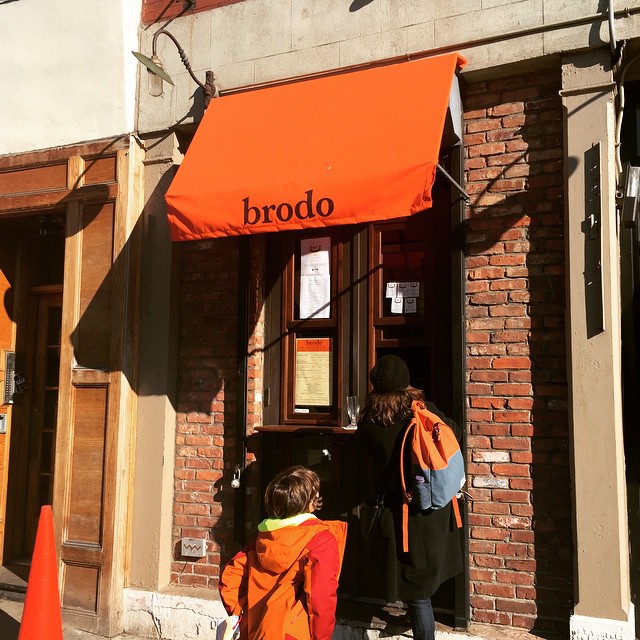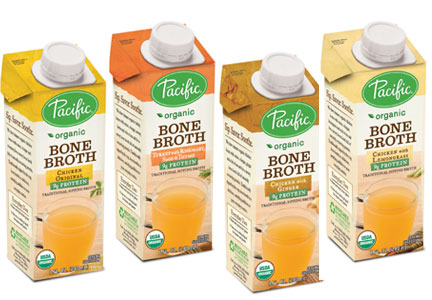What Is The Future Of Bone Broth? We Asked An Expert. And A Psychic.
After the hottest summer on record, business is beginning to pick up again at Brodo in New York City's East Village. "It's getting colder now," says the cute beanie-capped clerk, handing over a hot cup of the house's signature item: a hearty beverage made from "whole stewing hens, turkey legs, beef shin, chicken feet, water, onions, carrot, celery, whole tomato, parsley, sea salt, black pepper, bay leaf," according to the menu. Lucky me; a fresh batch of the stuff has just arrived at the takeout window on this chilly Friday evening.
If you've never tried bone broth before, just imagine the most silky protein-rich gravy you've ever had, served at a molten-hot temperature. Be careful: The first sip can be a scorcher! At Brodo, a 16-ounce serving will set you back $8.50, which isn't altogether unreasonable when you factor in time and labor; this stuff can take a whole day or so to cook. In fact, that's what distinguishes bone broth from the common stock, as any bone broth buff will tell you. The extended cooking time (anywhere from 12 to 48 hours) helps to extract more minerals, nutrients and gelatin from the bones, which are sometimes roasted beforehand.
And, oh, so discreet! At Brodo, the broth is served in a standard paper coffee cup, with the usual protective brown sleeve and plastic lid. Walking down First Avenue, cup in hand, passersby have little idea that I've succumbed to another food craze. It just looks like I'm having a latte.
In a Food Republic interview last January, acclaimed chef Marco Canora, the proprietor of Brodo and the adjoining decade-old restaurant, Hearth, described his brothy sideline as an extension of his overall increased interest in health and wellness, particularly his own. A life in restaurants had left its inevitable marks — high cholesterol, high blood-sugar levels, gout — and the chef was now doing things differently, following a sort of adapted paleo diet, for one thing; drinking more broth played a big role. "I'm not a doctor; I'm not a nutritional scientist; I'm not a research specialist," he said. "I'm just a guy who knows how to cook really well and has started to care a lot more about what I eat, and I've been trying to educate myself the best I can. And now I'm trying to share some of that with people."
Canora isn't the only one, either. For months afterward, bone broth seemed to be everywhere. Beyond Brodo, health-minded NYC spots Mulberry & Vine and Mimi Cheng's both started serving it. In my own Brooklyn neighborhood, you could pick up a fresh cup at a number of places, including the farmers' market and the butcher shop. And for those New Yorkers who don't want to go out, a new startup subscription service began delivering quarts of bone broth to private homes. Last March, the city's first bone broth festival took place in the South Street Seaport, leading some food-world commentators to suggest that the trend had peaked.
Outside of New York City, you could find it at places like Hassa in Washington, D.C., and Blackbelly Market in Boulder, Colorado. New specialty shops were in the works, too, including Broth Bar in Portland, Oregon, and Bone Tea Broth Bar in London. Even the Missouri-based Panera Bread chain was getting into the action, putting its own spin on the trend with its heavily advertised "broth bowls."
Then summer arrived, and the warmer weather had a chilling effect on the hot-beverage phenomenon. The sudden about-face was quickly evident at Fleisher's, my local butcher shop, which scrubbed the buzzword from its sandwich board and moved its remaining bone broth supply into the freezer. A Fleisher's rep promised that the shop would resume serving it hot again in the fall.
Perhaps the brightest future for bone broth is as an ingredient, not a meal in a cup.
Now that autumn is finally kicking into its usual chilly gear, the timing seems right for a big bone-broth comeback.
Ask a retail expert, and you'll hear all sorts of reasons as to why the bone-broth trend will not fade away anytime soon. Nicole Peranick, a director of global consumer strategy at Daymon Worldwide, for one, points to how well it dovetails with so many other prevailing food trends: the popular paleo diet, the rise of waste-nothing nose-to-tail dining, the increased interest in digestive health, the deepening influence of Asian cuisine and America's general on-the-go eating culture.
Peranick further notes that bone broth is beginning to transcend its usual specialty-shop trappings and is now expanding into supermarkets. She points to Oregon-based Pacific Foods, which recently came out with its own line of packaged bone broth. You can find it in the soup aisle. But the versatility of this particular product means that you could soon start seeing it in all sorts of places: at the meat counter, the health-food section, the ready-to-eat aisle, maybe even its own stand-alone kiosk, where shoppers can, say, build their own bone-broth bowl.
But perhaps the brightest future for bone broth is as an ingredient, not a meal in a cup, Peranick says. And why not? A few splashes is an easy way to enrich the nutrition content of all sorts of dishes.
Then again, foodie culture is fickle, and fads, no matter how healthy, popular or seemingly unstoppable, have a tendency to flame out almost as quickly as they blew up. Skeptics would say, for instance, that it's only matter of time until today's green juice goes the way of yesterday's salad bar.
Indeed, the juicing trend seems an apt comparison. Like bone broth, it's a quick, easy way to get your nutrition fix in a matter of gulps. And for a while, anyway, the modern juice boom seemed limitless. But now there are signs of a slowdown. One of NYC's most popular juice chains, Organic Avenue, a business that once boasted 10 stores and plans to add another six as recently as 2014, shuttered all of its locations earlier this month.
Will ambitious bone-broth sellers one day face the same fate?
As I ponder this grim possibility, crossing the heavily trafficked intersection at Second Avenue and St. Marks Place, my cup of broth now cooled to a less tongue-searing degree, a voice calls out: "What are you waiting for?" I turn around and come face to face with an arcade fortune-teller machine like the one from the 1988 fantasy-comedy film Big. "I am Zoltar, the great gypsy," it says, "and I can see your fortune. Come see it, too." For $2, the contraption promises to reveal some prescient insights. That's quite a price hike from the film version, which charged just 25 cents. Still, it's a mere quarter of what my broth cost. And if you're as big a fan of the movie as I am, then you understand the possible implications.
OK, Zoltar, tell me: What is the future of bone broth? Asking for a friend. I look down at the cup of broth. "CAUTION," the lid warns. "CONTENTS HOT." I insert two bucks. Some mystical harp music begins playing, and the animatronic psychic comes alive. "Listen carefully," Zoltar tells me. "It is better to keep your mouth shut and be thought a fool than to open it and remove all doubt."
Not good: This smart-ass machine is basically telling me what a sucker I am for drinking this stuff.
The chatty contraption continues: "And also, my friend, it is wise to be taking good advice when you hear it, no?" And that's it: two lines of wisdom for two bucks. But the last part at least gets me thinking about what Brodo's Marco Canora said. I'm not a doctor or a nutritionist, either. But I also care a lot about what I eat, and I've been trying to educate myself, too.
If the experts think I should be drinking this stuff, what harm is there in playing along? At least until the next magical health potion comes along.



